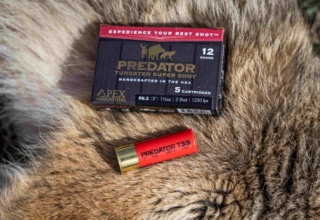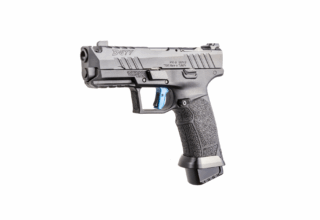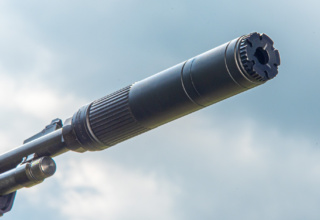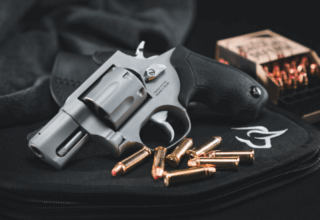There are many ways to enhance your enjoyment of the shooting sports. Some are complicated and pricey, others require some basic learning and are quite reasonable. Reloading your own ammunition can be both financially rewarding and satisfying. I remember quite well, building my own muzzle loading rifle from a kit 3 days before deer season – and the thrill I got when it actually worked. I managed to bag my deer on opening day, with the first shot from the new smoker.
I got the same rush from my first trip afield with ammunition I had loaded myself. If you’ve ever thought about reloading and hesitated because of fearing the expense or doubting your ability, I have some good news. Like any facet of the shooting sports, there are many ways to spend a lot of money, get buried with information, and end up with things you don’t need. None of this is necessary or desirable to me.
When I was in high school, I received a brand new Ithaca 16 gauge Featherlight pump action shotgun for my 13th birthday . I used it for hunting everything from squirrels to deer. Not being the richest kid on the block, there were times when I went on a local safari with a grand total of 5 or 6 shot shells to my name. Most shotgun ammo was around a $1.50 to $3 a box and that was a bit pricey for me at the time. The hunting vest I got for Christmas that same year, was kind of pathetic with all of those empty loops. Eventually, having read everything I could find about reloading, I purchased the most basic version of the Lee Loader for about ten bucks. In addition, I paid about 75 cents for primers, 2 dollars for wads, 3 dollars for powder, and 2 something for a 25
pound bag of shot (boy, how times have changed). Finally, I was in business!
 The various operations to go from empty hull to a loaded shell, required time, care, and determination. The product I produced, was less than professional, but it functioned (usually), was safe, and provided a cheaper way to shoot, plus a great way to spend an afternoon. Some years later, I acquired my first “big bore” handgun, a two inch Smith & Wesson Chief’s Special. A .38 was a big deal to me at the time and once again feeding it at $5 a box, was a bit much. A friend of mine was reloading .38 wadcutters and would sell them to me for $1.50 a box. I started looking for my own loader, and soon bought a box of used reloading items from a sporting goods store, without knowing exactly what I was getting. When I got the box home, I discovered it included a Lyman tong tool (operates like a pair of pliers), a Lyman manual, a .38 wadcutter mold, a bullet sizer, scales, .38 Special dies and two loading blocks.
The various operations to go from empty hull to a loaded shell, required time, care, and determination. The product I produced, was less than professional, but it functioned (usually), was safe, and provided a cheaper way to shoot, plus a great way to spend an afternoon. Some years later, I acquired my first “big bore” handgun, a two inch Smith & Wesson Chief’s Special. A .38 was a big deal to me at the time and once again feeding it at $5 a box, was a bit much. A friend of mine was reloading .38 wadcutters and would sell them to me for $1.50 a box. I started looking for my own loader, and soon bought a box of used reloading items from a sporting goods store, without knowing exactly what I was getting. When I got the box home, I discovered it included a Lyman tong tool (operates like a pair of pliers), a Lyman manual, a .38 wadcutter mold, a bullet sizer, scales, .38 Special dies and two loading blocks.
Once again, I could afford to shoot more, even though I wasn’t going to set any production records. I also learned how to cast my own bullets on Mom’s gas stove,(not recommended) but that’s another story. Getting started today is a lot easier than it was in my youth. We have information and equipment available now that was not even imagined forty years ago. The variety of products is astounding and will fit any budget. Loading data is readily available on the internet and there are a ton of apps you can download to your phone or tablet.
If you have decided to give it a go, here are the basic things required for pistol cartridges. First, you will need to pick out a press you can mount on a sturdy bench – unless you want to go with a handheld tool. A bench mounted tool, can be a single-stage press, or a turret loader. With a single stage, you complete each operation for all of the cases you are planning to load, changing dies after each step. In other words, you de-prime all of the cases before you change dies. A turret loader, on the other hand, allows you to thread all of your dies into a “turret”, which is manually or automatically rotated when each step is completed. This allows a complete cartridge to be produced, before going to the next casing. You will need a powder measure of some kind(dipper or dispenser), and scales to verify the powder charge at the beginning and periodically while you load. Loading dies are caliber specific and should be carbide – assuming you are loading pistol cartridges. Carbide dies eliminate the need to lube the cases. I use Lyman, Lee and RCBS dies. The appropriate shell holders are available from all three companies. Incidentals run the gamut. I have some loading blocks, empty cartridge boxes, and always keep some sandwich bags handy.
 Gathering up components doesn’t have to be complicated either. Start by looking in your loading data for the caliber, bullet weight, and velocity you want. Note the powder choices, bullet type, and minimum/maximum velocities. Plan on starting slightly above the minimum load. Your ammunition will likely be for practice initially, and this is a good approach. You can tune the load to your particular firearm after getting some experience. Once you have made your choices, shop for the best price (not at the expense of quality), add some primers (I normally use Winchester or Federal), once fired brass, powder, and bullets. Do not buy numerous powders, bullet types, etc. when you are starting out. It is unnecessary and can get confusing. I also prefer cast bullets for most of my practice.
Gathering up components doesn’t have to be complicated either. Start by looking in your loading data for the caliber, bullet weight, and velocity you want. Note the powder choices, bullet type, and minimum/maximum velocities. Plan on starting slightly above the minimum load. Your ammunition will likely be for practice initially, and this is a good approach. You can tune the load to your particular firearm after getting some experience. Once you have made your choices, shop for the best price (not at the expense of quality), add some primers (I normally use Winchester or Federal), once fired brass, powder, and bullets. Do not buy numerous powders, bullet types, etc. when you are starting out. It is unnecessary and can get confusing. I also prefer cast bullets for most of my practice.
Reloading is a lot like landing an airplane( trust me, I use to fly for a living). You need a systematic approach, and you follow the
manual. I try to get everything set up, and then do the steps in the same sequence every time. First, inspect the cases for cracks, etc..
Set up the loader following the manufacturers instructions. Adjust the dies. Find the appropriate shell holder. Fill the powder
dispenser and charge a case. Weigh the charge (powder dispensers are either adjustable, have a bushing, or a disk that dispenses a fixed amount) and pour it back into the dispenser reservoir. If you are using a dipper, pour some powder into a separate open top container. Cut down cardboard ice cream containers are excellent for this.
 Once you are satisfied that everything is ready, insert a fired case into the shell holder and pull the lever. This will size and de-prime the casing. You should be conscious of any abnormal “feel” or resistance. On my loader, the return stroke primes the case. This necessitates placing a primer in the primer arm on the loader. There are also separate hand priming tools that work as well. The next step is to charge the case with powder, either by means of a powder dispenser or a dipper. The die used in this step is hollow, which allows the powder to fall through it into the case. It will also “bell” the mouth slightly, allowing you to properly place the bullet on the case. The last step is to place a bullet, base down, on the mouth of the case and seat it by pulling the lever once again. If it is a straight walled cartridge, such as a .38 Special, a slight crimp will be added to hold the bullet firmly. Now, inspect the round. Any cracks, bulges, crinkles, high primer, or loose bullet? No? Good, you have just successfully loaded your first cartridge. As you continue to learn, and your confidence grows, you will see that it is well within your abilities to reload your own ammunition in many calibers. There is nothing scary about it, but there are a few things to note.
Once you are satisfied that everything is ready, insert a fired case into the shell holder and pull the lever. This will size and de-prime the casing. You should be conscious of any abnormal “feel” or resistance. On my loader, the return stroke primes the case. This necessitates placing a primer in the primer arm on the loader. There are also separate hand priming tools that work as well. The next step is to charge the case with powder, either by means of a powder dispenser or a dipper. The die used in this step is hollow, which allows the powder to fall through it into the case. It will also “bell” the mouth slightly, allowing you to properly place the bullet on the case. The last step is to place a bullet, base down, on the mouth of the case and seat it by pulling the lever once again. If it is a straight walled cartridge, such as a .38 Special, a slight crimp will be added to hold the bullet firmly. Now, inspect the round. Any cracks, bulges, crinkles, high primer, or loose bullet? No? Good, you have just successfully loaded your first cartridge. As you continue to learn, and your confidence grows, you will see that it is well within your abilities to reload your own ammunition in many calibers. There is nothing scary about it, but there are a few things to note.
1. Keep your reloading area free of spilled powder and debris.
2. Follow reloading manuals EXACTLY. Start low and work up. STICK
WITH THE DATA.
3. Throw away defective cases and other components. They are cheap,
accidents are not.
4. Focus on the task at hand. Do not let your mind wander.
5. DO NOT ALLOW OTHERS TO USE YOUR RELOADS.
6. Do not have more than 2 or 3 kinds of powder. There are legal limits on storage.
7. Keep in mind, some firearms manufactures, void the warranty when you use reloads.
8. MAKE SURE THE PRIMERS ARE NOT UPSIDE DOWN IN THE CASES(Been there)
9. Keep a log of the components and powder charge used and label.
10. ALWAYS WEAR SAFETY GLASSES
 If I was just beginning, I would probably buy a reloader’s kit from Lee Precision, Lyman, or RCBS. There is nothing wrong with the other brands, these are my personal favorites because of price, variety, and quality. These kits contain all you need to get started, and may or may not include the dies. In any event, I hope you try reloading and enjoy it. I have learned a lot from it, saved some money, and really enjoyed “rolling” my own.
If I was just beginning, I would probably buy a reloader’s kit from Lee Precision, Lyman, or RCBS. There is nothing wrong with the other brands, these are my personal favorites because of price, variety, and quality. These kits contain all you need to get started, and may or may not include the dies. In any event, I hope you try reloading and enjoy it. I have learned a lot from it, saved some money, and really enjoyed “rolling” my own.
- Reloading Your Own Ammo - January 4, 2019












